Hello everybody!
With me ‘still absent’, Donald Hill was so kind to ready not only the usual Don’s Weekly, but also a special feature for today. Indeed, we’re starting this week with the latter, because we think The Battle for Stepove it’s the crucial show-down, probably decisive for the outcome of this winter’s campaign.
***
Two months into the Russian offensive on Avidiivka, it’s about the time to recap the developments on one sector of the frontline in this area.
The Keystone Cops have initiated this offensive by focusing on the two flanks of Ukrainian defences of Avidiivka, hoping they could punch through and then meet in the middle, encircling Ukrainian garrison or forcing it to withdraw.
Virtually no advances have been made in the south and progress was slow in the north, so the Russians opened an all-out, frontal push that managed to take the industrial park north of the ruined town - before that seems to have stalled, as well. Meanwhile, the Russians are starting to put pressure on Ukrainian defenses three kilometers east of the coke factory and we’ll see what comes of that. But so far the only significant progress Russia has made has been the 2.5-3 km gains in the north The following is a resume of how this all has happened.
***
Almost all of the videos have been shown before. They are being used again to illustrate a point.
Like many places along the frontline, the Avdiivka sector has been attacked since February, 2022, but for the four months prior to the October offensive the front was pretty stable. As the Ukrainian summer offensive efforts wound down, Russia was looking for an opportunity to conduct a major push. The Russian military doctrine dictates the maintenance of initiative, and this is best done through offensive action. The side with the initiative is picking the time and place of the battle, and thus dictating the action. This is the way the Russian military officers are indoctrinated to think and lead their forces from the start of their military education, all the time through their careers: when forced to defend because of a stronger enemy force, they will still look for opportunities to counterattack and disrupt the enemy. This is why they continuously attack at Kupiansk, Bakhmut, and Svatove, too. If they take territory, great. If not, it keeps Ukraine in a defensive posture - even if, sure: costing Russia incredible amounts of men and equipment.
Besides, both Putin and his Keystone Cops want Avidiivka - as much as they wanted Bakhmut, a year ago. It is their aim, and they’re going to use all the conventional means at their disposal to achieve it.
***
Since Avidiivka was already in a deep pocket and surrounded on three sides at the start of this battle, Russia hoped that a strong push on both flanks would either encircle the town or narrow the passage so much that it would be too costly to supply the city and the defenders in the pocket.
In order for the northern flank to do its part in cutting off Avdiivka, Russian forces would have to take both Stepove and the coke factory.
On the first day of the offensive, Russia was able to grab 300 meters of treeline when attacking across the first field. Russian artillery pounded that treeline and their tanks and APCs provided direct fire support while the infantry dismounted. And the Russians launched wave after wave of attacks that added to the Ukrainian casualties, forcing Ukrainians in foremost lines to expend their ammunition and their machine guns and mortars to start overheating. But what really aided the Russians was a perpendicular wood-line leading right into the Ukrainian defensive line which provided cover for assailants. Even worse, that perpendicular wood-line zigzagged 300 meters away, providing even more cover for the Russians.
The cost for the Russians was high, both in personnel and vehicles. In the first five days there was a minimum of 45 vehicles visually confirmed as completely obliterated. It’s hard to say how many more were destroyed but not visually confirmed but the terrain east of the slagheap rapidly filled with wreckage of all sorts of Russian armoured fighting vehicles.
Regardless of murderous losses, the Russians continued attacking. This soldier fought south in Avidiivka but what he describes is a widespread experience:
https://twitter.com/wartranslated/status/1715631066982105127
***
Over the next 15 days Russia managed two things:
relentless artillery fire gradually demolished Ukrainian field fortifications, in turn
enabling Russian troops to capture the rest of that treeline.
Various parts of the treeline had been seized by the Russians several times but Ukrainian counterattacks would always push them out and reoccupy the defensive lines. Artillery from both sides would hit the treeline prior to their assaults and at some point the trenches were no longer viable defensive positions. Without trenches, Ukrainian troops would be exposed to heavier casualties from artillery, even if they held the line. The cost was too high; they fell back to the double treelines on either side of the railroad. Putin and Keystone Cops don’t mind casualties, do not mind paying a massive price, so their commanders continued sending ever more troops to take over the treeline and continued attacking towards the railroad without a pause. The amount of vehicles they lost was staggering: https://twitter.com/wartranslated/status/1714931914262425978
***
The Russians also started digging in, even while under artillery fire and drone attacks. This is similar to their tactics at Bakhmut, where the first wave would walk as far towards the Ukrainian lives as they could, then the survivors would halt and start digging in so the next wave would have protection. But the Russians not only started digging defensive positions, they also started to dig a tunnel across the field.
Russian-constructed defensive tunnels were first noticed during the Ukrainian summer offensive in the Robotyne area, in southern Zaporizhzhya, four months ago. They are allowing Russian troops to resupply and move troops while protected from Ukrainian observation and fire. At Avidiivka, they were used to safely move across the open field and emerge only when they were close to Ukraine’s defensive positions. This example of the Russians being caught in an open field is what they sought to avoid through the use of such tunnels:
https://twitter.com/PStyle0ne1/status/1713920673561674079?s=20
And both the Ukrainians and Russians started using small wheeled robots controlled by operators to bring supplies to exposed positions, and Ukraine has also evacuated a wounded soldier by a cargo drone:
https://twitter.com/bayraktar_1love/status/1733447207964090700
https://www.thedefensepost.com/2023/10/25/ukraine-russia-tunnels-robotics/?expand_article=1
Finally, the Russians grinded Ukrainian defences to the point where they were able of encroaching the base of the slagheap. At that point, they began sending infantry assault groups up the steep sides. Although none of those assaults was successful, they continued keeping Ukrainians busy, even causing them losses - and definitely a high expenditure of ammunition, and that at the time Ukraine began receiving at least 30% less from the West, which was meanwhile preoccupied with developments in Israel/Palestine.
One Ukrainian estimated that the Russians lost 20-30% of their vehicles alone before reaching their forward line to launch an attack. This diagram of the first week of the offensive indicates some of that:
https://twitter.com/OSINTua/status/1714604462159835285
Moreover, the Russians began targeting the Ukrainian infantry on top of the slagheap with drones. Even with defensive positions, there was no place to hide.
Finally, the Russian advances west of Krasnohorivka and by the slagheap allowed them to conduct direct fire on the route Ukraine used to supply and bring replacements to their defenses southwest of Krasnohorivka.
To the luck of the ZSU, back in September the Ukrainian 47th Mech Brigade was withdrawn from the Robotyne sector and placed in the line north of Avdiivka: thus, through October, one of Ukrainian units with highest firepower was in good position to defend approaches to Stepove and the coke factory from the east.
Unable to supply and send reinforcements to their defenses southwest of Krasnohorivka, the Ukrainians finally ordered their troops back to the railroad and the adjacent treeline, the next day. However, due to that withdrawal, the Russian assaults towards the railroad were no longer hit in the flanks and they were able to threaten the Ukrainian defenses there.
There was also just one road up to the heights of the slagheap and it could now be interdicted by Russian fire from within completely demolished former Ukrainian defence positions:
(…to be continued…)

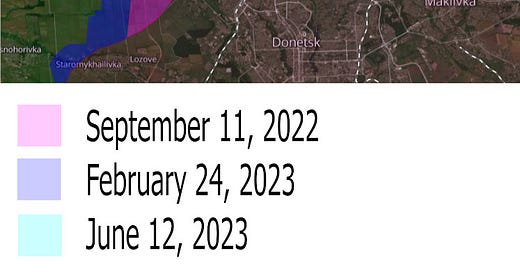



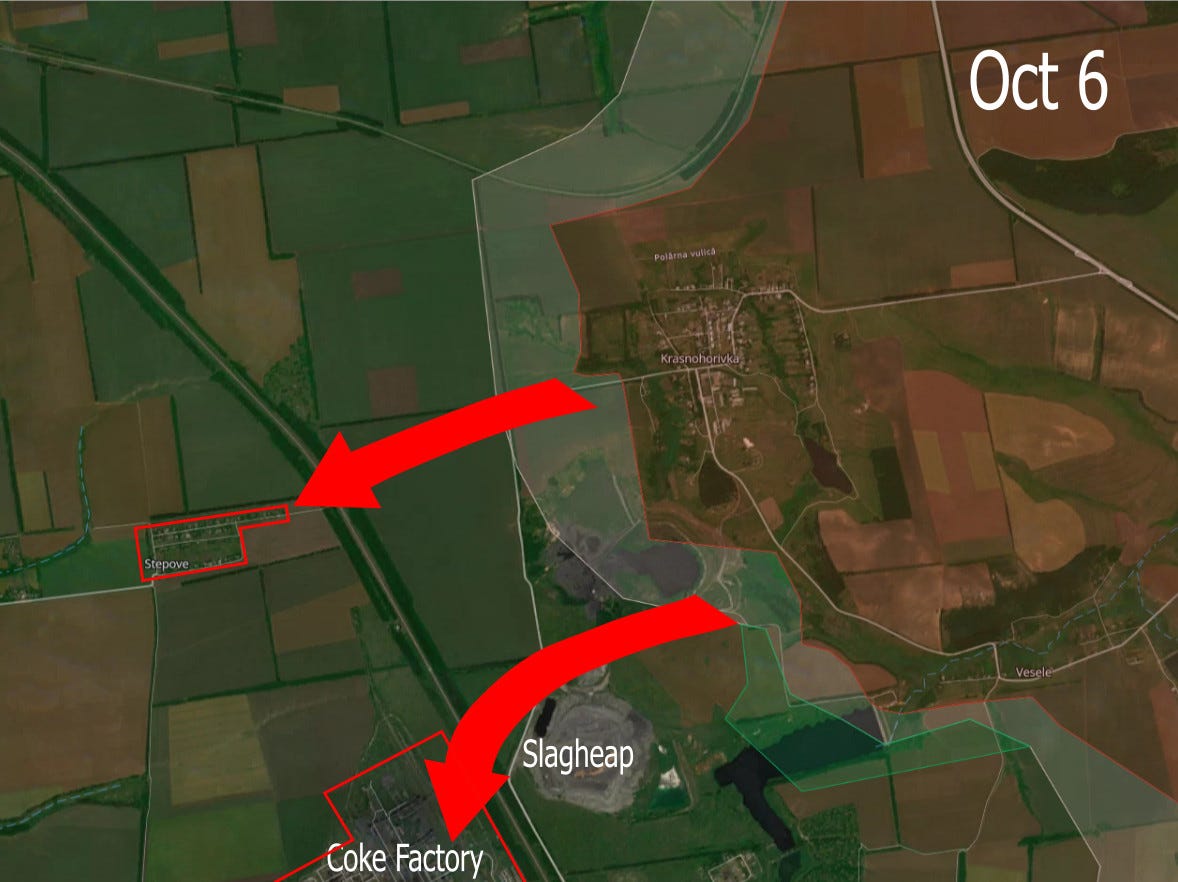
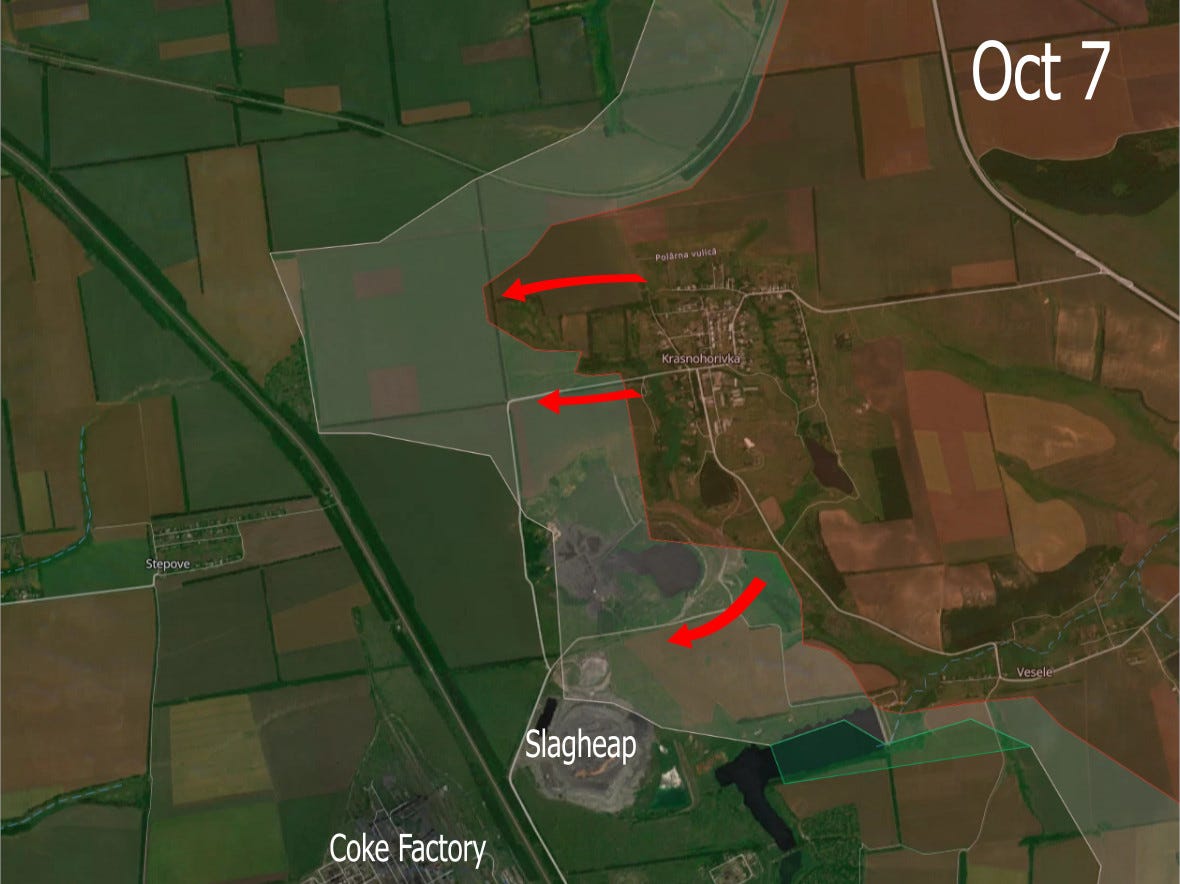
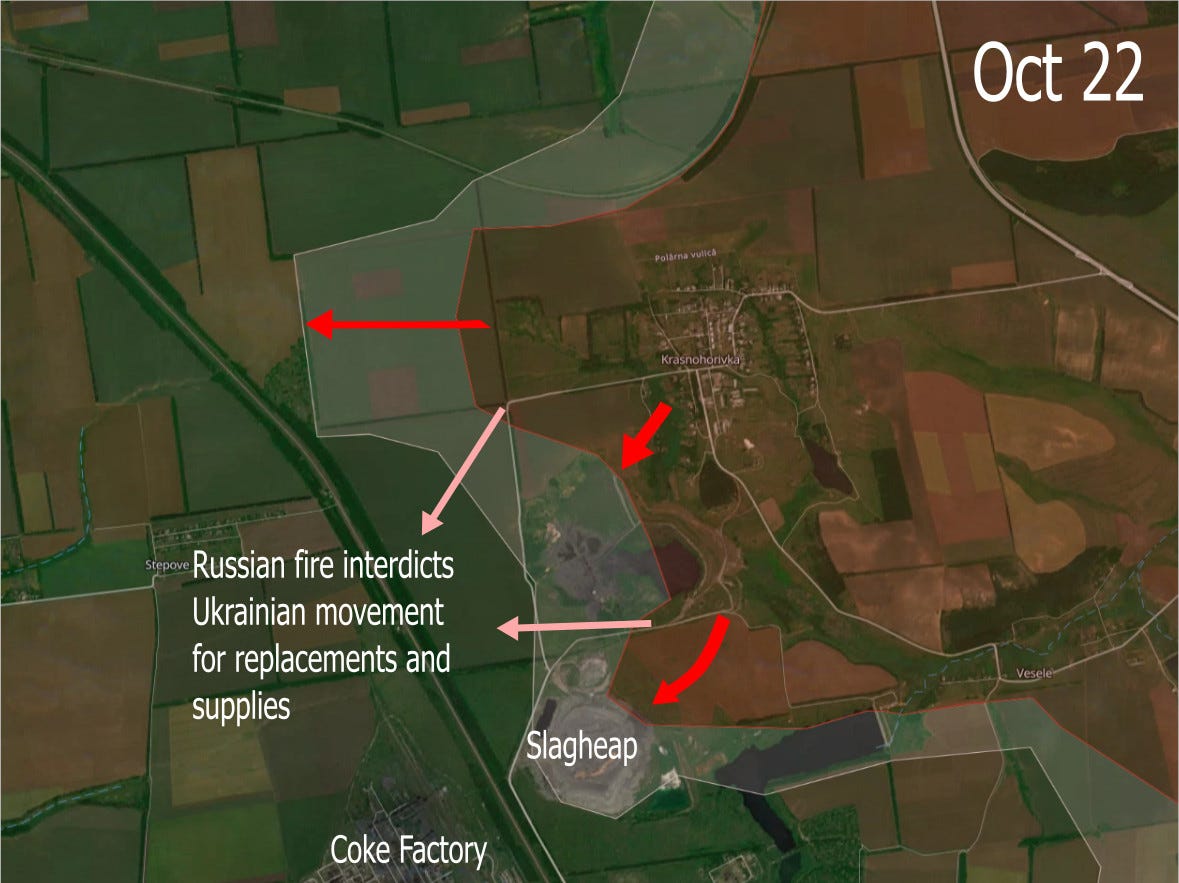
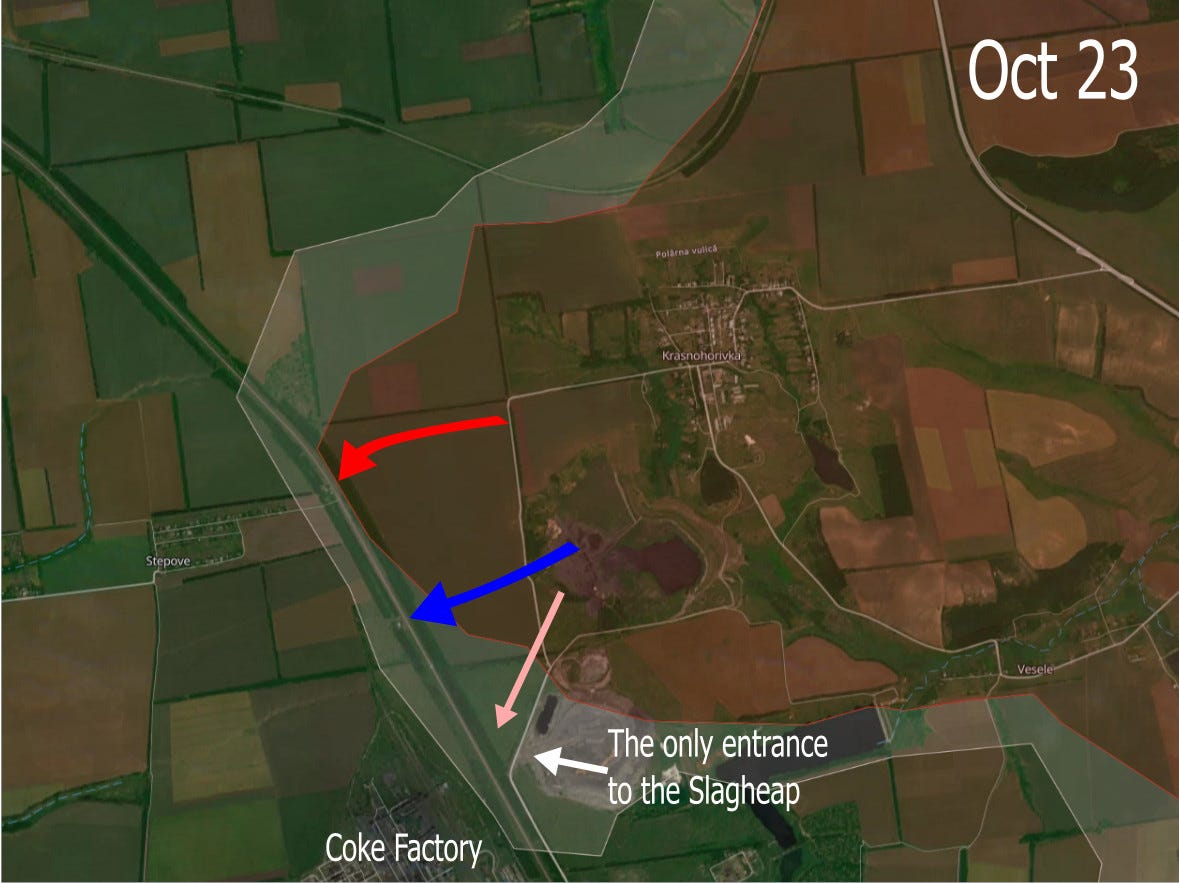

Thanks Tom! Waiting impatiently for the latest updates
What does it all means while a disgusting show is taking place in the USA! Maybe this show of political puppets is the only decisive thing of this winter campaign.